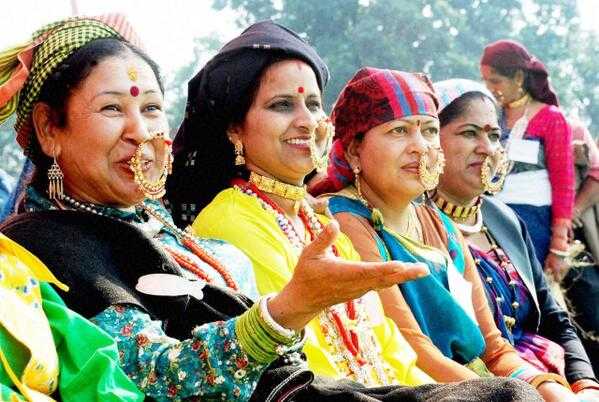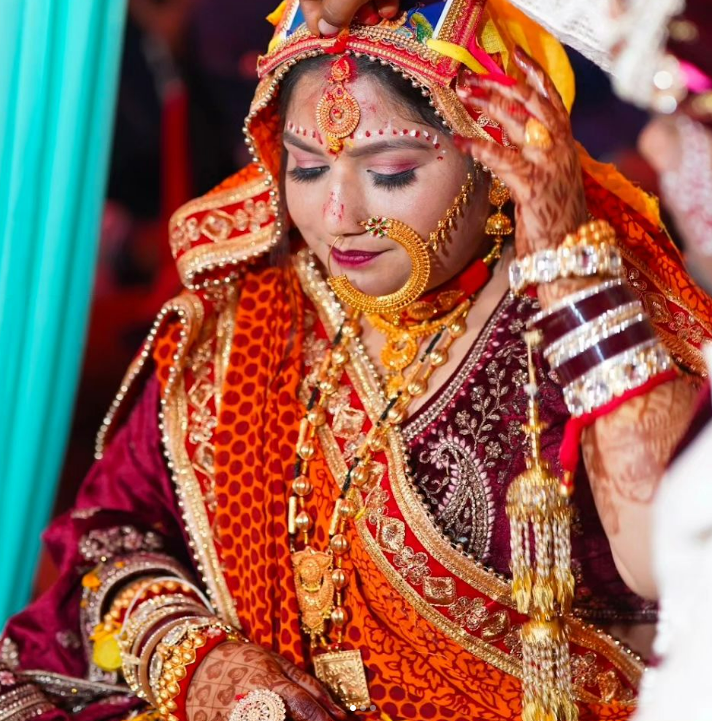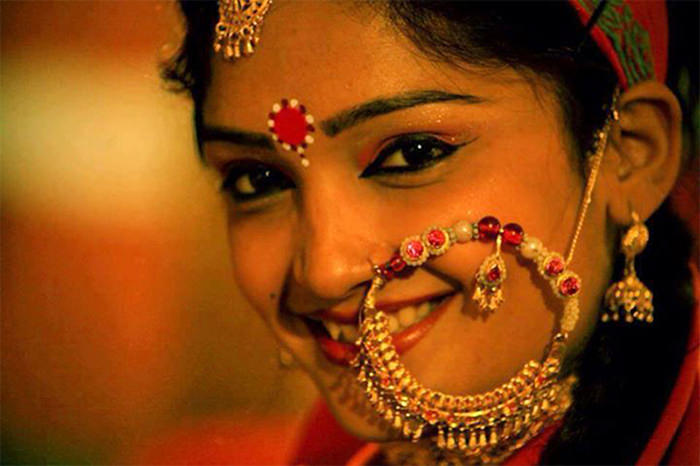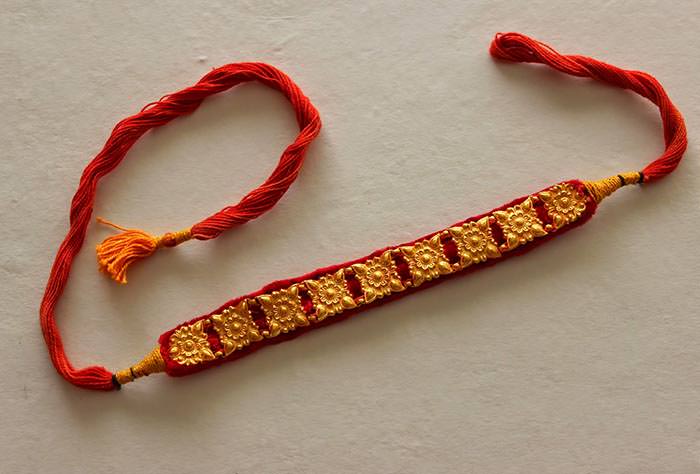Known to the locals as Uttaranchal, Uttarakhand is well-known throughout India for its sacred sites. Located in the mountainous Himalayan region, this Devbhoomi (Land of Gods) is a well-liked tourist destination.
Depending on which region they are from, Uttarakhand is home to both Garhwalis and Kumaonis. Music and dance are essential components of its rich culture. There are many different languages spoken here, including Hindi, Bhoti, Kumaoni, and Garhwali. An important component of traditional Uttarakhand clothing is jewelry made of silver and gold. Women in Uttarakhand are known for wearing gold kundal (earrings) and frequently having several ear piercings. People from a variety of ethnic backgrounds, including Rajputs, Brahmins, and tribal people, live in Uttarakhand.
Garhwali Traditional Dresses
Women’s Traditional Dresses
Women in this Northern state’s Garhwal region typically wear saris tied in a specific manner, with a cloth waistband and the pallu knotted on the shoulder and extending from the front. Women find this convenient because it facilitates food transportation and doesn’t impede their ability to work in the fields. In the past, the sari was worn with a silver-buttoned Angra (blouse) with full sleeves to keep the women warm. They also wear a headscarf scarf to carry the harvest and shield their hair from harm.
Married women were expected to wear a silver necklace known as chareu, black beads, a guloband (which looks like a modern choker), and hansuli (a silver ornament worn around the neck).
Hansuli
A lady with a gold bulaq mounted on her nose. It was customary for a newlywed woman to wear a large gold septum ring known as a bulaq. The bride’s family provided it as a dowry. An important occasion in this community is weddings. The bride wears a red ghaghra, along with gold jewelry such as a kamar bandh (silver), bulaq, guloband, maang teeka, and a large nath (nose ring).

Uttarakhand Traditional Dress for Men
Specifically, married women wear it. The clothing has a red dot painted on it and is yellow in color. The bride wears this pichhora primarily when she gets married.
Depending on their age, Garhwali men typically dress in a kurta and either pyjamas or a churidar. In the community, this is the most typical outfit. To stay warm, the younger generation pairs this with a topi, while the older men pair it with a pagadi. As a result of British influence, many men also began wearing suits. The type of fabric used for clothing varies depending on the climate of the area; cotton is used in warmer climates and wool in colder ones.
The traditional wedding attire for the groom is still a yellow kurta and dhoti.
When men used to walk long distances, they kept their silver coins in a pouch tied around their bodies to keep them safe from theft.

Kumaoni Traditional Dresses
Women’s Traditional Attire
The women of Uttarakhand’s Kumaon region are typically seen wearing a ghagra as a blouse with a kameez (shirt). This is very similar to what many Rajasthani women wear. Additionally, women dress in , a traditional wedding and ceremony attire. This was traditionally made at home and dyed yellow. On their wedding day, women still wear this traditional pichora. pichora is most imopatent dress of traditional dresses of uttarakhand.
Married women in the Kumaon region wear sindoor, bichuye (silver toe rings), hansuli, black beaded necklaces or chareu, and large gold naths that cover their entire cheek. They were regarded as required. A woman wearing traditional Pithoragarh jewelry

Men’s Traditional Attire
The typical attire of men in the Kumaon region is similar to that of Garhwali. They also dress in kurtas, pyjamas, and a topi or turban. On the other hand, they are seen with jewelry around their hands or necks. A characteristic unique to the Kumaon area traditional dresses of uttarakhand.
Traditional Attire of the Tribal Community
According to the 2001 Census, there are primarily five tribes in Uttarakhand: the Tharu, Jannsari, Buksa, Bhotia, and Raji. With the exception of the Bhutia tribe (25.8%), who are also highly prevalent in urban areas, the majority of these live in rural areas. The districts of Pithoragarh and Udham Singh Nagar in Kumaon division, as well as Dehradun and Chamoli in Garhwal division, are home to the majority of the tribal population.
Jaunsaris
According to Jaunsaris, they are descended from the Pandavas of Mahabharat. They are different from their Garhwali neighbors because of their unique fashion sense, which is bright and adorned with a lot of jewelry. Even the men wear a traditional woolen cloth cap called a digwa, along with jewelry such as necklaces, kadas, and earrings. Women dress in a dhantu (scarf), a woolen coat, and a ghagra. They don long coats called Thalka or Lohiya during festivals.

Bhotia
The Mongoloid ethnic group known as the Bhotia is a pastoral and agricultural community. They live in the state’s higher elevations, where the weather is cold. They stitch their wool clothing and weave woolen yarn. Women’s traditional attire consists of a coat, waistcoat, shirt, and skirt. They typically wear gold or silver nose rings, beads, and rings around their necks, ears, and nose. The men usually wear pants and a loose gown with a woolen cap and a patta, a woolen cloth tied around the waist.
The Raji tribe, which primarily inhabits the woods, is the least developed of the five.

Uttarakhand Traditional Jewellery

Another well-known aspect of Uttarakhand is its exquisite traditional jewelry. Women typically wear the jewelry, though occasionally men do too. In Uttarakhand, women represent their social and economic standing as well as their rich cultural legacy. Women’s accessories include gold mangtik, silver anklets, silver and gold earrings, and necklaces.
The following are some examples of traditional dresses of uttarakhand female ornaments:
Bulaq, Nath: This gold and silver item is worn on the nose.
Kundal: (Earrings in gold and silver.)
It is worn on the hand (gold and silver bangles) in Paunjee, Dhagul.
Gold is a shish fool. Mangtika
It is worn around the neck as a garland of gold and silver. Globand, Hasuli, Mala, and Haar.
Jhaveri and Payal are worn on the feet. (made of gold and silver)
Pichora for Women

Kumaoni women are known for their iconic traditional dress, the pichora, which they wear particularly at weddings and religious festivals.
It is a garment that resembles a yellow and red dupatta and is heavily embroidered with gold or silver, signifying joy and prosperity. The dress has sentimental and cultural significance in the area and is frequently handed down through the generations.
Pichoras are usually worn with a blouse with elaborate embroidery and a Ghagra, or skirt. Because the fabric is light—typically cotton—it is comfortable to wear every day.
During pujas or rituals, women wear it over their sarees. The vivid hues, especially red and yellow, represent good fortune and fortunate starts.
Kumaoni women are known for their iconic traditional dress of uttarakhand, the pichora, which they wear particularly at weddings and religious festivals.
It is a garment that resembles a yellow and red dupatta and is heavily embroidered with gold or silver, signifying joy and prosperity. The dress has sentimental and cultural significance in the area and is frequently handed down through the generations.
Pichoras are usually worn with a blouse with elaborate embroidery and a Ghagra, or skirt. Because the fabric is light—typically cotton—it is comfortable to wear every day.
During pujas or rituals, women wear it over their sarees. The vivid hues, especially red and yellow, represent good fortune and fortunate starts.
Nathuli
The allure of Pahari women, known as Nathuli or Nath, is celebrated for their exquisite fashion sense. nathuli is traditional dresses of uttarakhand .Women from Uttarakhand’s Garhwal, Kumaon, and Jaunsar-Bawar regions wear it. Though the design and style may vary between the two regions, its allure is the same. The focal point of the wedding is the bride’s nose ring, also known as her nath. The bride’s family status is indicated by the weight and quantity of pearls placed in a nath. One of Uttarakhand’s most prestigious ornaments, Tehri Nath is renowned for its artistic design and is worn during puja, social gatherings, marriage, and significant family occasions. This substantial item ofjewelry not only displays the vibrant culture of

Galobandh
Galobandh, also referred to as “Galabandh,” is a prominent piece of Kumaoni jewelry. one of most part of traditional dresses of uttarakhand is galobandh. Women from the Kumaoni, Garhwali, Bhotiya, and Jaunsari communities wear this prestigious neckpiece. As the name implies, only married women wear the galobandh, which is tied around the neck. The distinctive feature of Galobandh is its red belt design, which features exquisitely arranged golden square-shaped jewelry pieces held together by a thread. Despite being a sophisticated piece of jewelry, it is becoming outdated as modern jewelry has taken over the market, leaving traditional ornaments obsolete. Although the ornament is very popular among women in rural areas, it is not as well-liked by city dwellers.

